By going through these Maharashtra State Board Class 11 Geography Notes Chapter 4 Climatic Regions students can recall all the concepts quickly.
Maharashtra State Board Class 11 Geography Notes Chapter 4 Climatic Regions
Five Spheres of the Earth:
- Lithosphere
- Hydrosphere
- Biosphere
- Magnetosphere

![]()
→ The climate of any region is decided by detailed study and observation for a longer period of time such as 30 years.
→ The climate of a place is responsible for the variety in so many factors including our food, our occupations, our houses, our clothes and many activities.
→ Natural Regions – It is a basic geographic unit. Usually it is a region which is distinguished by its common natural features of geography, geology and climate.
Classification of Climate and Identifying Climate Regions :
Climate Regions:
Low latitude :
- Equatorial Rainforests
- Tropical Monsoon Climate
- Tropical Savannah Type of Climate
- Tropical Deserts or Arid Type of Climate
Mid Latitude:
- Mediterranean Climate
- China Type Climate or Humid Sub Tropical Climate
- Marine West European Type Climate
High Latitude:
- Taiga or Sub-Arctic
- Tundra
- Ice Sheet
- Highland or Mountain Type
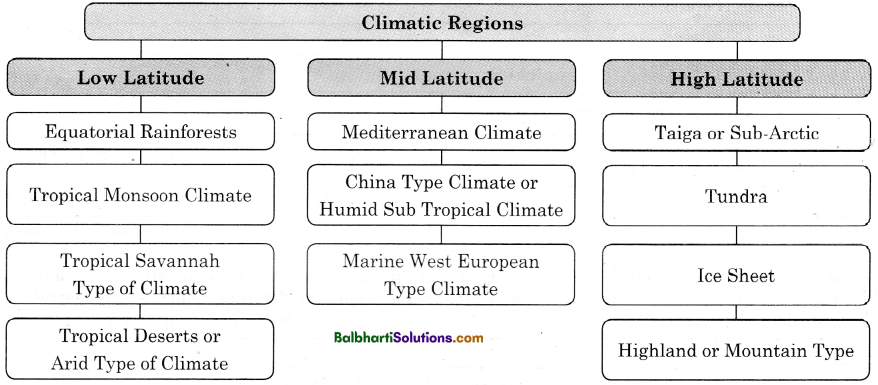
Low-latitude regions:

![]()
Tropical Monsoon Climate:
- SW India and SE Asia, SW Africa, NE and SE Brazil, northern parts of Australia, parts of tlapan]
- Summer temperature around 27°C to 32°C, winter temperature 15°C to 24°C j
- Rainfall, 250 to 2500 mm, orographic rainfall (India)
- High annual range of temperature
- Less biodiversity as compared to tropical forests
- Iron rich soils in high rainfall zones
- Large hooved leaf eaters and carnivores
- Paddy, rice agriculture
- 10° to 30° N and S
Tropical Savannah Climate:
- Herding and animal husbandry
- Tall and thick grass (Elephant grass), scattered drought resistant trees, broad towards the apex, scrub
- Between 10° to 20° N and S latitudes
- Summer temperatures around 35°C, winter temperatures around 24°C
- Average rainfall of 250-1000 mm
- Grazing more common, large herbivores, carnivores and scavengers
- Parts of peninsular India, rain-shadow zone in Maharashtra, Telangana, Karnataka, parts of Mizoram, Congo, south-central Africa, llanos of Venezuela, Campos of Brazil

Tropical Deserts or Arid type Climate:
- Xerophytic vegetation
- Between 20° to 30° latitude in both hemispheres
- Small nocturnal, burrowing animals
- Badaun, (Sahara), Bushmen (Kalahari), Aborigines (Australia)
- Agriculture practised near oases
- Summer temperature around 30°C to 45°C, winter temperature around 20°C to 25°C highest diurnal range, highest day-time temperatures
- Precipitation less than 200mm. Low or no humidity
- Western coasts of all continents, parts of Gujarat, Rajasthan and south west Haryana, Iran, interior parts of Asia, coastal Chile, Peru, south-west Africa, interior Mexico, Baja California, North Africa, Namibia and parts of US.
- Saline soil
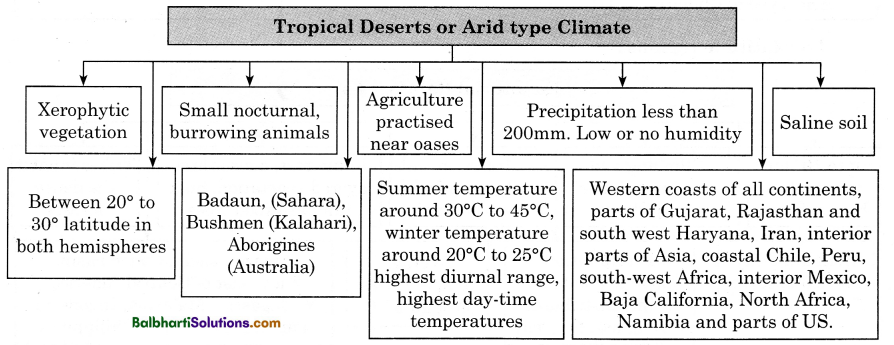
![]()
Mediterranean Climate:
Mid-latitude regions :
- Olives, grapes, vegetables, citrus fruits, animal husbandry
- Western Coastal region between 30° to 40° N and S
- Tourism, cinema industries
- 500 to 1000 mm winter rainfall, foggy coasts
- Coniferous vegetation in high altitudes, grass in areas of low rainfall
- Scrubs, leaves are evergreen, hard, thick leathery, usually small
- Central California, borders of Mediterranean Sea, Cape Town, Southern and SW Australia, Central part of Chile
- Mild, moist winters, temperature around 10°C to 14°C warm, dry summers, temperature around 21°C to 27°C quite sunny, high summer
China type Climate or Humid Sub – tropical Climate:
- East coast location between 20° and 40° N and S
- Mixed forests, grasslands, pines in higher altitudes.
- Rice, wheat, corn, cotton, tobacco, sugarcane, citrus fruits.
- Humid in summer, cyclonic storms in winter
- Precipitation between 600 to 2500 mm
- High humidity, hot summers, frost in winter
- Warmest months above 10°C, coldest between 0°C and 18°C
- SE USA, SE South America, coastal SE South Africa, Eastern Australia, Eastern Asia from through South China to Southern Japan, Easter island in Chile
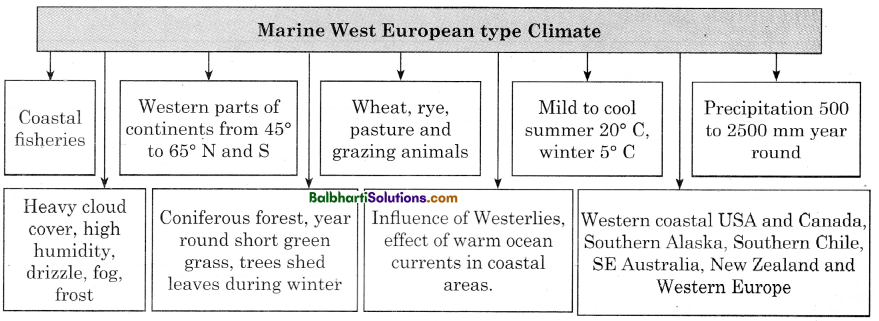
High-latitude region:

Tundra Climate:
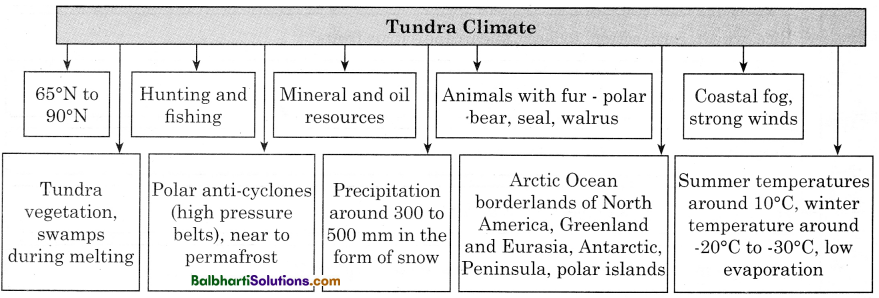
![]()
Ice Sheet:
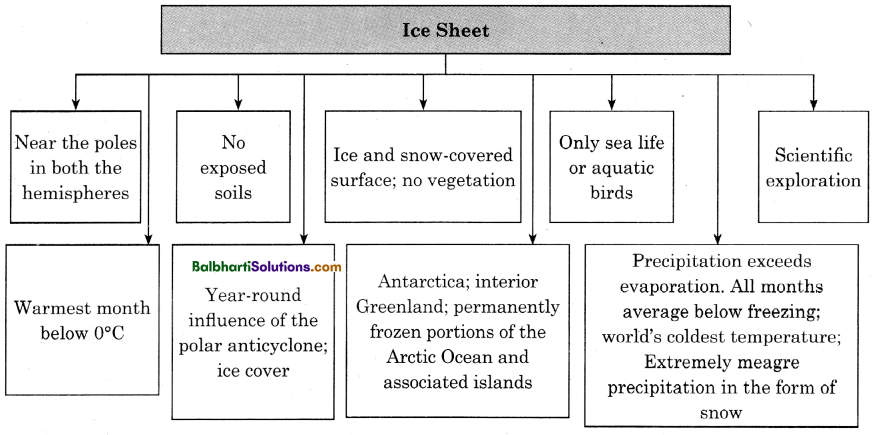
Highland or Mountain type:
- Grazing, pastures, terrace cultivation
- Laterite soils
- Tourism
- Widely over Earth
- Grazing, pastures, terrace cultivation
- Coniferous in higher reaches, tropical deciduous to evergreen, in lower reaches
- Orographic rainfall, snowfall in higher reaches
- The climate depends on altitude, location on the leeward or windward side
- Mountains in Asia, central Europe, western North, and South America